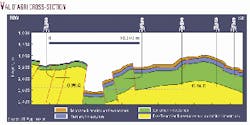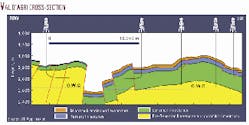Italy is still coming to terms with the existence of an estimated 1.02 billion bbl of recoverable reserves tucked beneath the rolling hills of its southern Apennines.
The world's fifth largest economy and third-ranked user of hydrocarbons in Europe is currently less than 20% self-sufficient in energy, being heavily reliant on Libya and Algeria for its oil and gas supplies. Now Italy can lay claim to the largest onshore reserves on the continent considered to be Europe's most promising onshore development area.
Furthermore, seismic data indicate that the major onshore producing sections in the Val d'Agri and Tempa Rossa fields, are also present offshore (OGJ, Dec. 20, 1999, p. 144). The Italian government recently opened these offshore areas for competitive tender.
The Val d'Agri project comprises three fields: Monte Alpi (discovered 1988), Monte Enoc (1994), and Cerro Falcone (1992), respectively located on the Grumento Nova, Volturino, and Caldarosa concessions. The fields account for a combined 600 million bbl of oil equivalent. Associated gas forms around 7% of the total.
ENI, Italy's 35% state-owned oil and gas conglomerate, operates the fields in a joint venture with Enterprise Oil PLC. In June 1999 the two partners signed a preliminary agreement unifying the concessions of Grumento Nova and the northern areas of Caldarosa and Volturino in a 71/29% split in ENI's favor. This accord is still subject to final ministerial approval.
Development, production
Development of the three fields includes the drilling of 42 production wells, 20 of which have been completed. Three of these are under long-term test and are already producing some 11,000 b/d between them. One of these is from nearby Tempa Rossa field, a separate project in itself.
Also part of the development program is the renewal of the existing Monte Alpi oil center at Viggiano, opened in 1996 and with a current production of 9,000 b/d. At present production is limited by the trucking capacity on the road route used to transfer the oil to Taranto. A 150-km buried pipeline to the Taranto refinery and marine terminal will be laid later this year ready for the increase in production in second quarter 2001. The terminal itself will be expanded and upgraded with an extended jetty and new storage tanks to accommodate anticipated export flows.
Production from Val d'Agri field is expected to reach 104,000 b/d by 2002, doubling Italy's current production of crude oil. This will be the third step in a three-phase process seeing production rise first to 45,000 b/d and then 63,000 b/d before it reaches the 2002 target.
Neighboring Tempa Rossa field, discovered in 1998, adds a further estimated 420 million bbl of reserves to the area. The project incorporates the Gorgoglione and Tempa d'Emma concessions, now unified into one with ENI as operator and ENI, Enterprise Oil, Total Fina and Exxon Mobil each holding a 25% stake. The accord was reached following the partners' joint acquisition of Lasmo's interest in the field, including nearby exploration acreage, for $33.6 million.
Field complexities
The Tempa Rossa crude is much heavier than Val d'Agri's, said ENI's asset manager for both fields, Gianfranco Amici. Val d'Agri's 2% sulfur content and 38° gravity compares with 6% sulfur and 20° gravity at Tempa Rossa. "And we are talking of seven wells at Tempa Rossa instead of 42. The project is close to being sanctioned, and we plan to start work this summer," he added.
Tempa Rossa's five existing and two future (one exploration and one appraisal) wells will be connected, and a new 50,000 b/d oil center built together with a pipeline link to the Val d'Agri-Taranto pipeline. Production from Tempa Rossa is expected to reach 44,000 b/d by 2003.
Amici noted that the geology of the whole area is complex.
"There's a new 3D seismic campaign being carried out in Val d'Agri now to acquire the best information. The area is a very thick carbonate reservoir with several folds crossing it, so it is difficult to assess its image until you drill the well but you have to try to get the best image in order to minimize the well risk.
"In this kind of structure where you have folds and tilted blocks it is difficult to plan wells without risk. But the seismics are giving us the best planning tool available, and now after 20 wells we are getting a good image of the reservoir's shape.
"We are using innovative techniques in the drilling, too," Amici said. "We have drilled horizontal wells and horizontal Christmas trees... This is part of our approach to minimize the environmental impact. We are electrifying the rigs to avoid noise and the emissions of the diesel generators. And we have multiwell locations so we have only 26 locations for the 42 wells.
Environment, social concerns
The Basilicata area, originally proposed as a national park, is one of Italy's most important in terms of beauty and environmental value, Amici said.
The national park was not established, but an accord has finally been reached with Basilicata regional authorities that encompasses environmental restoration including reforestation, social programs such as vocational training, and the promotion of local industrial ventures.
The regional agreements also include a contribution to a gas distribution network and creation of an Environmental Obser-vatory. Their conclusion led to the start of construction of the new oil center targeted to produce first oil in first quarter 2001.
"This has been a depressed area in the past, and we are promoting local industrial growth, too," said Amici. Coupled with this is "our approach to mitigate the impact on the environment by using the latest methodologies and to compensate the local communities."
All this follows some tough rounds with Basilicata regional authorities. Amici described the dialogue between the two sides as deadlocked when he arrived on the scene. Considerable delays were caused in issuing authorizations (the process was started in 1996) associated with bureaucratic bottlenecks and the resolution of environmental concerns.
ENI's development expenditure at Val d'Agri amounts to some Euro 1.02 billion ($960 million) compared to Euro 62 million at Tempa Rossa. This includes a figure of Euro 144 million in contributions under the Basilicata regional accord.


